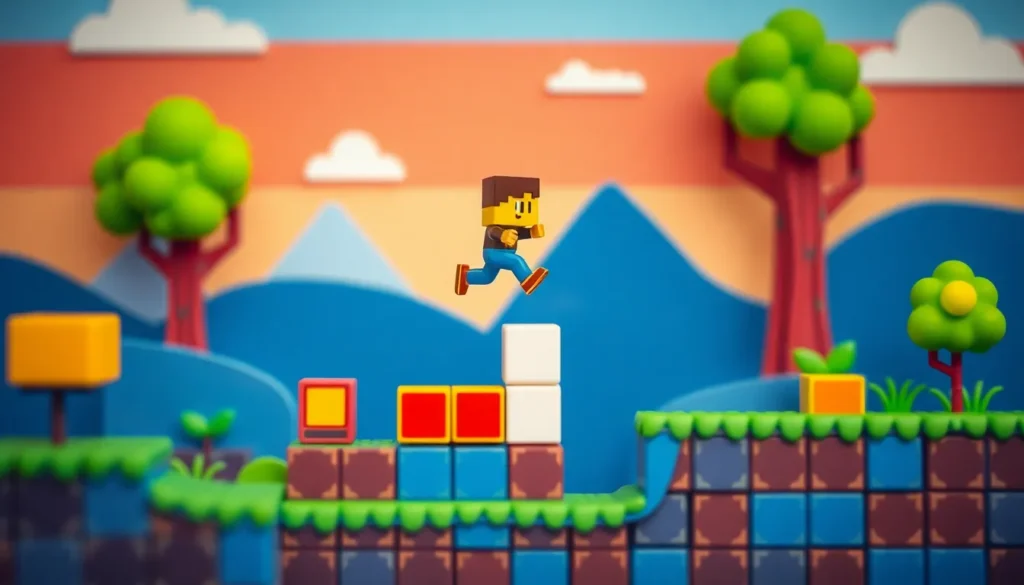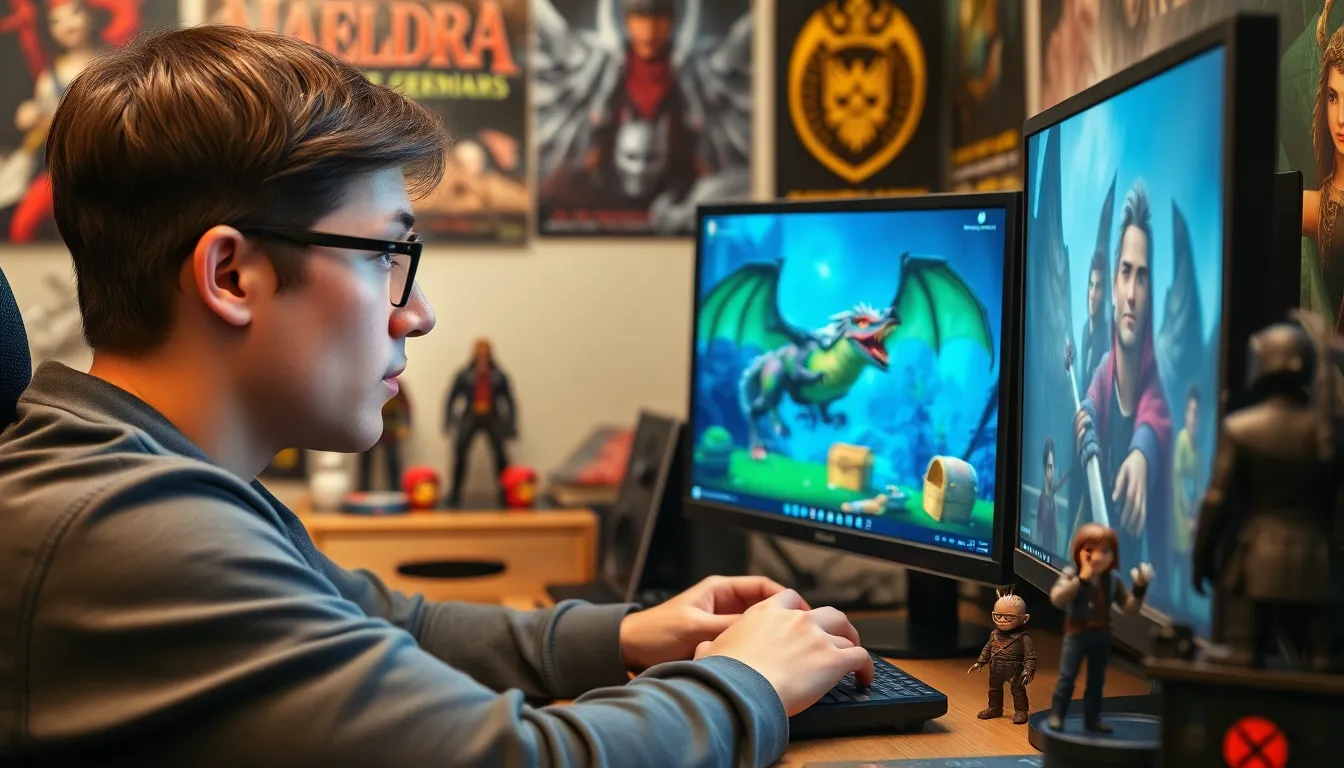In a world dominated by high-definition graphics and complex gameplay, low-bit game design stands out like a retro gem in a sea of flashy distractions. This charming approach to game development celebrates simplicity and nostalgia, drawing players in with its pixelated art and straightforward mechanics. Who knew that less could actually be more?
Table of Contents
ToggleOverview of Low-Bit Game Design
Low-bit game design stands out for its unique aesthetic and gameplay. This design approach relies on limited color palettes and simple animations, capitalizing on nostalgia for retro games. Pixel art often defines the visual style, evoking memories of 8-bit and 16-bit consoles. Developers create experiences emphasizing creativity over technological advancement.
Limited graphics encourage innovation in storytelling and gameplay mechanics. Simple controls can lead to highly engaging experiences. Games like “Celeste” and “Shovel Knight” illustrate how low-bit design can deliver rich narratives and intricate gameplay, reminding players of the joy in challenging yet straightforward mechanics.
Accessibility plays a crucial role in the appeal of low-bit games. Players often appreciate the lower hardware requirements, allowing a wider audience to enjoy these titles. Additionally, the straightforward design fosters inclusivity, making it easier for both seasoned gamers and newcomers to participate.
Many independent developers gravitate toward low-bit styles due to their production cost-effectiveness. Creating art and mechanics with fewer resources allows small teams to produce quality games. This trend emphasizes creativity, bringing unique visions to life without a significant financial burden.
Overall, low-bit game design champions minimalism while maximizing player engagement. This approach reveals how less can indeed create a more meaningful gaming experience, inviting discussions about the future of both indie and mainstream game development.
Key Characteristics of Low-Bit Game Design

Low-bit game design stands out due to its distinctive features and approach. The simplicity of this style creates a unique charm that resonates with many players.
Pixel Art Aesthetics
Pixel art aesthetics define low-bit games, relying on a limited palette of colors for visual appeal. This art form cultivates nostalgia, evoking memories of classic gaming from the 1980s and 1990s. Games such as “Celeste” and “Shovel Knight” showcase how pixel art can effectively convey mood and atmosphere. Characters and environments in these games emerge as recognizable and meticulously designed elements, often featuring exaggerated expressions and whimsical designs. Additionally, the charm of pixelated visuals often encourages developers to focus on creativity, making the most out of constrained graphical capabilities.
Simplistic Game Mechanics
Simplistic game mechanics characterize low-bit games, ensuring accessible gameplay for diverse audiences. The straightforward controls and intuitive interfaces allow quick learning and enjoyment. Many low-bit games prioritize engaging experiences over complex mechanics, often emphasizing exploration and creativity. Players can easily navigate through levels without feeling overwhelmed by intricate systems or rules. Titles like “Super Mario Bros.” exemplify how rewarding gameplay emerges from simplicity, fostering player satisfaction and engagement through easily digestible challenges. These mechanics often remind players that enjoyment often lies in uncomplicated designs and interactive worlds.
Historical Context
Low-bit game design has roots in the early days of video gaming. This style emerged prominently during the 1980s and 1990s when developers faced hardware limitations.
Emergence of Low-Bit Games
Low-bit games became popular with the introduction of consoles like the Nintendo Entertainment System and Sega Genesis. These systems featured 8-bit and 16-bit graphics, shaping a distinctive visual identity. Simplicity characterized the gameplay, allowing players to quickly grasp mechanics. Subsequently, developers focused on creativity to engage players, crafting memorable experiences within technical constraints. Notable titles, including “Super Mario Bros.” and “The Legend of Zelda,” pushed boundaries, establishing the foundation for low-bit aesthetics.
Evolution Over Time
Over the years, low-bit game designs adapted and thrived as technology evolved. Indie developers embraced this style in the 2000s, intentionally replicating retro visuals. Games such as “Fez” and “Braid” exemplified how pixel art could convey complex narratives and emotions. Advancements in digital distribution also facilitated wider access to low-bit games. Players now enjoy a resurgence, highlighting nostalgia among diverse audiences. Today, studios blend traditional styles with modern techniques, showcasing the enduring appeal of low-bit design.
Contemporary Examples of Low-Bit Games
Low-bit games thrive in the gaming industry, showcasing unique creativity and engaging experiences. These games, often developed by independent studios, underline the blend of nostalgia and innovation.
Indie Game Success Stories
“Celeste” stands out as a remarkable piece of low-bit design, captivating players with its heartfelt narrative and challenging platforming mechanics. “Shovel Knight” has garnered acclaim for its retro aesthetics and engaging gameplay, emphasizing streamlined controls and classic game design. “Undertale” enchants with its distinctive approach to characters and storytelling, allowing players to impact the game’s outcome through choices. Collectively, these success stories illustrate how minimalist designs can produce deeply resonant experiences, encouraging developers to embrace simplicity in their projects.
Popular Platforms for Low-Bit Games
Steam remains a leading platform for distributing low-bit games, providing visibility for indie developers. itch.io offers a space for smaller companies and independent creators, promoting experimental titles. The Nintendo Switch features a variety of low-bit games, appealing to players who appreciate retro experiences. Mobile devices, equipped with touch controls, create an accessible environment for low-bit games, allowing users to enjoy engaging mechanics on the go. Gamers can explore diverse titles across these platforms, reinforcing the widespread popularity of low-bit design in contemporary gaming.
Impact on Game Development
Low-bit game design significantly influences modern game development through its focus on simplicity. Developers often prioritize pixel art and straightforward mechanics, allowing for innovative storytelling in a constrained format. An example is “Celeste,” which combines minimal graphics with a rich narrative, demonstrating how engaging experiences emerge from limited visual elements.
Accessibility plays a crucial role in expanding player demographics. Many low-bit games require less powerful hardware, attracting both seasoned gamers and newcomers alike. This inclusivity fosters a welcoming environment for diverse audiences, enabling them to engage without feeling overwhelmed.
Developers frequently turn to low-bit styles for their cost-effectiveness. Small teams can create compelling games without the financial strain associated with high-end graphics. The success of titles like “Shovel Knight” showcases the viability of this approach, as independent studios thrive by adopting retro designs.
Historical context enriches the understanding of low-bit game’s impact. Originating in the 1980s and 1990s, early video games often faced hardware limitations. Consequently, these constraints led to memorable gameplay mechanics, as seen in classics like “Super Mario Bros.” and “The Legend of Zelda.”
Contemporary independent games build on this legacy by intentionally replicating retro visuals. Titles like “Fez” and “Braid” reveal that pixel art can effectively express complex emotions and narratives. The growth of digital distribution on platforms such as Steam and itch.io increases visibility for low-bit games, enhancing accessibility for both developers and players.
Current trends in low-bit game design demonstrate a blend of traditional styles and modern techniques. Creatively engaging experiences emerge from minimalism, inviting players to appreciate both nostalgia and innovation. Ultimately, low-bit design continues to shape the future of game development, proving that less can indeed offer more.
Conclusion
Low-bit game design stands as a testament to the power of simplicity in the gaming world. Its nostalgic visuals and straightforward mechanics resonate with players of all ages, creating an inclusive environment that welcomes both veterans and newcomers. The resurgence of this style highlights how creativity can flourish within constraints, leading to memorable experiences that often outshine their high-definition counterparts.
As developers continue to explore the potential of low-bit aesthetics, the future looks bright for this beloved genre. By embracing the charm of pixel art and innovative storytelling, the gaming community can anticipate a continued evolution that celebrates both nostalgia and modern creativity.






